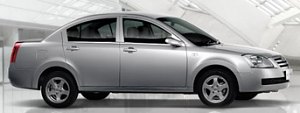
| Qoros - 50% |
| Chery
Jaguar Land Rover - 50% |
Qoros: HQ in Shanghai, design & engineering offices in Munich (Germany) and Graz (Austria), main plant in Changshu.
2021: 961,926 units
2016: 617,700 units (704,700 units including JLR and Qoros)
2015: 502,800 units
2014: 486,100 units
2013: 423,200 units
2012: 566,500 units
2011: 643,000 units
2010: 682,058 units
2009: 501,000 units
2008: 356,000 units
2007: 381,000 units
2006: 305,200 units
2016 sales by brand:
Chery: 363,314 units
Jaguar/Land Rover: 62,468 units
Qoros: 24,483 units
2016 domestic sales by model:
QQ + eQ: 33,158 units
Fulwin 2: 42,231 units
E3: 16,230 units
E5: 14,322 units
Arrizo 3: 1,246 units
Arrizo 5: 128,938 units
Arrizo 7: 17,151 units
Tiggo 3: 118,414 units
Tiggo 5: 55,075 units
Tiggo 7: 34,177 units
Qoros 3 (all derivatives): 24,483 units
Jaguar XF L: 5,644 units
Land Rover Discovery Sport: 26,557 units
Range Rover Evoque: 12,759 units
Reference:
http://www.chery.cn
http://www.qqbenz.com/
http://www.qichexl.com/a/xiaoliangpaixing/
Initially, it acquired the license of old SEAT Ibiza from Volkswagen group for production in its new Wuhan plant. Then, in 2003, it introduced a pair of copycat designs, QQ and Eastar, which closely modelled Daewoo Matiz and Magnus respectively. This caused some legal disputes with General Motors and a bad image overseas. Its Tiggo SUV of 2005 was also a clone to Toyota RAV4.
 Chery A5 (2006) - the first real own
design
Chery A5 (2006) - the first real own
designSince then Chery began showing some originality. The A3, A5, A6 and G6 were developed with the help from external engineering consultants, such as Italdesign and Pinifarina (styling), Lotus (chassis dynamics), AVL Austria (engines) and Ricardo (hybrid powertrain). In particular, Chery supplied its ACTECO engines to the FIAT cars assembled in China. Meanwhile, it also established overseas assembly plants through joint-ventures in developing countries like Argentina, Iran, Turkey and Thailand. With around a third of its production exported, Chery was the biggest exporter among Chinese car makers.
However, as competition in the domestic market got intensified, the self-developed models became the victims of their international rivals. It ran into loss since 2009 and its sales declined after the peak in 2010. As a result, it abandoned its multi-brand strategy and diverted its resources to joint-ventures - Qoros (a JV with an Israeli firm) and a JV with Jaguar Land Rover.